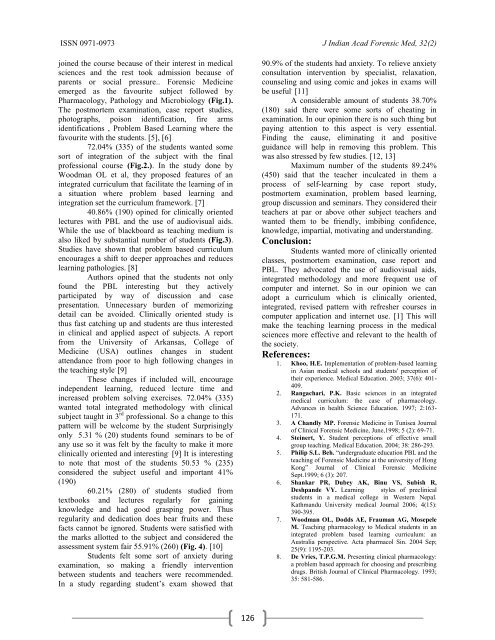jiafm, 2010-32(2) april-june. - forensic medicine
jiafm, 2010-32(2) april-june. - forensic medicine
jiafm, 2010-32(2) april-june. - forensic medicine
- No tags were found...
You also want an ePaper? Increase the reach of your titles
YUMPU automatically turns print PDFs into web optimized ePapers that Google loves.
ISSN 0971-0973 J Indian Acad Forensic Med, <strong>32</strong>(2)joined the course because of their interest in medicalsciences and the rest took admission because ofparents or social pressure.. Forensic Medicineemerged as the favourite subject followed byPharmacology, Pathology and Microbiology (Fig.1).The postmortem examination, case report studies,photographs, poison identification, fire armsidentifications , Problem Based Learning where thefavourite with the students. [5], [6]72.04% (335) of the students wanted somesort of integration of the subject with the finalprofessional course (Fig.2.). In the study done byWoodman OL et al, they proposed features of anintegrated curriculum that facilitate the learning of ina situation where problem based learning andintegration set the curriculum framework. [7]40.86% (190) opined for clinically orientedlectures with PBL and the use of audiovisual aids.While the use of blackboard as teaching medium isalso liked by substantial number of students (Fig.3).Studies have shown that problem based curriculumencourages a shift to deeper approaches and reduceslearning pathologies. [8]Authors opined that the students not onlyfound the PBL interesting but they activelyparticipated by way of discussion and casepresentation. Unnecessary burden of memorizingdetail can be avoided. Clinically oriented study isthus fast catching up and students are thus interestedin clinical and applied aspect of subjects. A reportfrom the University of Arkansas, College ofMedicine (USA) outlines changes in studentattendance from poor to high following changes inthe teaching style . [9]These changes if included will, encourageindependent learning, reduced lecture time andincreased problem solving exercises. 72.04% (335)wanted total integrated methodology with clinicalsubject taught in 3 rd professional. So a change to thispattern will be welcome by the student Surprisinglyonly 5.31 % (20) students found seminars to be ofany use so it was felt by the faculty to make it moreclinically oriented and interesting . [9] It is interestingto note that most of the students 50.53 % (235)considered the subject useful and important 41%(190)60.21% (280) of students studied fromtextbooks and lectures regularly for gainingknowledge and had good grasping power. Thusregularity and dedication does bear fruits and thesefacts cannot be ignored. Students were satisfied withthe marks allotted to the subject and considered theassessment system fair 55.91% (260) (Fig. 4). [10]Students felt some sort of anxiety duringexamination, so making a friendly interventionbetween students and teachers were recommended.In a study regarding student‟s exam showed that90.9% of the students had anxiety. To relieve anxietyconsultation intervention by specialist, relaxation,counseling and using comic and jokes in exams willbe useful . [11]A considerable amount of students 38.70%(180) said there were some sorts of cheating inexamination. In our opinion there is no such thing butpaying attention to this aspect is very essential.Finding the cause, eliminating it and positiveguidance will help in removing this problem. Thiswas also stressed by few studies. [12, 13]Maximum number of the students 89.24%(450) said that the teacher inculcated in them aprocess of self-learning by case report study,postmortem examination, problem based learning,group discussion and seminars. They considered theirteachers at par or above other subject teachers andwanted them to be friendly, imbibing confidence,knowledge, impartial, motivating and understanding.Conclusion:Students wanted more of clinically orientedclasses, postmortem examination, case report andPBL. They advocated the use of audiovisual aids,integrated methodology and more frequent use ofcomputer and internet. So in our opinion we canadopt a curriculum which is clinically oriented,integrated, revised pattern with refresher courses incomputer application and internet use. [1] This willmake the teaching learning process in the medicalsciences more effective and relevant to the health ofthe society.References:1. Khoo, H.E. Implementation of problem-based learningin Asian medical schools and students' perception oftheir experience. Medical Education. 2003; 37(6): 401-409.2. Rangachari, P.K. Basic sciences in an integratedmedical curriculum: the case of pharmacology.Advances in health Science Education. 1997; 2:163-171.3. A Chandly MP. Forensic Medicine in Tunisea Journalof Clinical Forensic Medicine, June,1998; 5 (2): 69-71.4. Steinert, Y. Student perceptions of effective smallgroup teaching. Medical Education. 2004; 38: 286-293.5. Philip S.L. Beh. “undergraduate education PBL and theteaching of Forensic Medicine at the university of HongKong” Journal of Clinical Forensic MedicineSept.1999; 6 (3): 207.6. Shankar PR, Dubey AK, Binu VS, Subish R,Deshpande VY. Learning styles of preclinicalstudents in a medical college in Western Nepal.Kathmandu University medical Journal 2006; 4(15):390-395.7. Woodman OL, Dodds AE, Frauman AG, MosepeleM. Teaching pharmacology to Medical students in anintegrated problem based learning curriculum: anAustralia perspective. Acta pharmacol Sin. 2004 Sep;25(9): 1195-203.8. De Vries, T.P.G.M. Presenting clinical pharmacology:a problem based approach for choosing and prescribingdrugs. British Journal of Clinical Pharmacology. 1993;35: 581-586.126



![syllabus in forensic medicine for m.b.b.s. students in india [pdf]](https://img.yumpu.com/48405011/1/190x245/syllabus-in-forensic-medicine-for-mbbs-students-in-india-pdf.jpg?quality=85)



![SPOTTING IN FORENSIC MEDICINE [pdf]](https://img.yumpu.com/45856557/1/190x245/spotting-in-forensic-medicine-pdf.jpg?quality=85)

![JAFM-33-2, April-June, 2011 [PDF] - forensic medicine](https://img.yumpu.com/43461356/1/190x245/jafm-33-2-april-june-2011-pdf-forensic-medicine.jpg?quality=85)



![JIAFM-33-4, October-December, 2011 [PDF] - forensic medicine](https://img.yumpu.com/31013278/1/190x245/jiafm-33-4-october-december-2011-pdf-forensic-medicine.jpg?quality=85)


